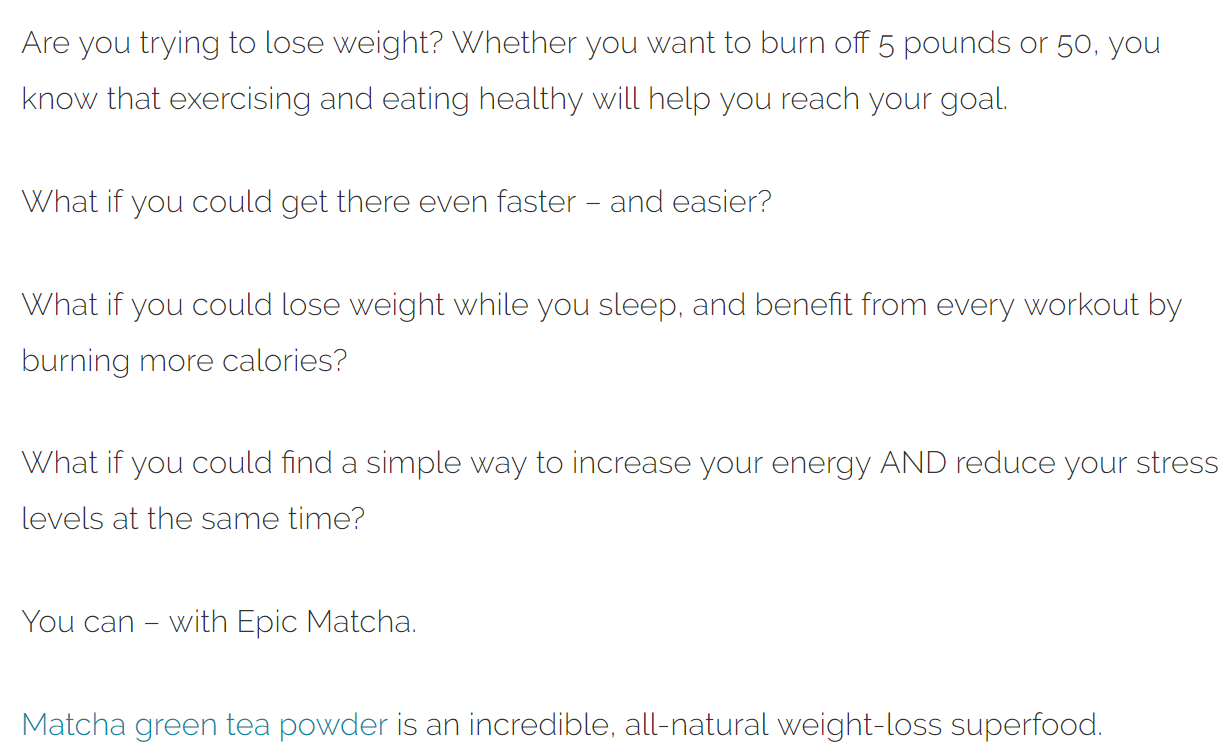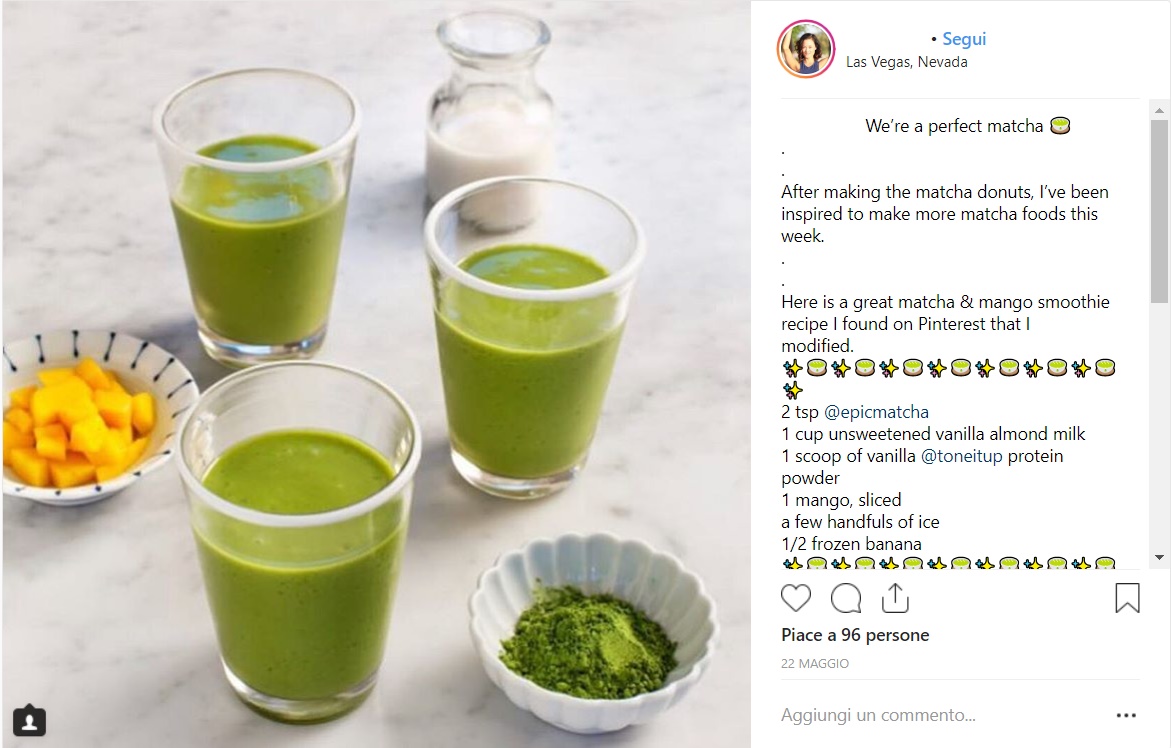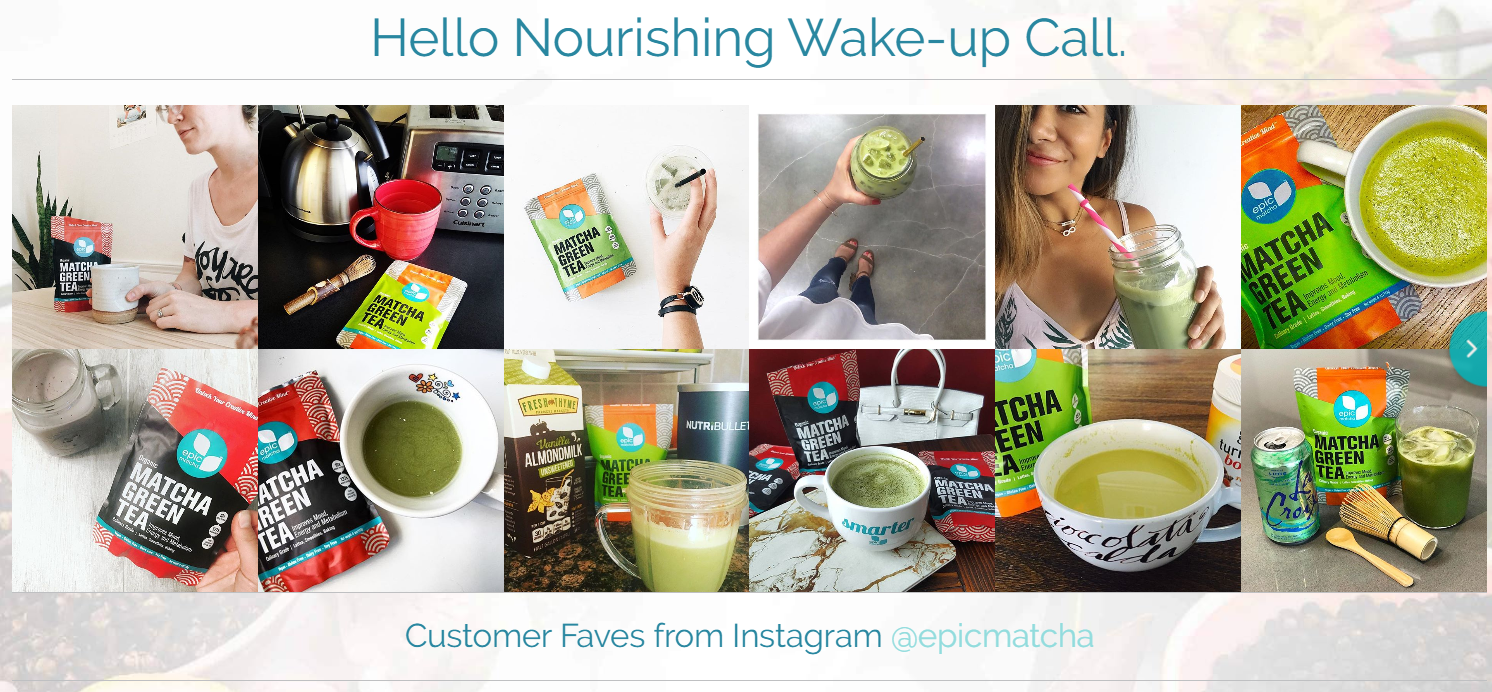
Matcha: Don't let yourself be fooled by superfoods
This article deals with the reasons behind the growing popularity of matcha, powdered green tea, in western countries.
Nowadays many people are interested in weight loss and in pursuing healthy lifestyles. Matcha is especially associated with having health benefits because of its high antioxidant content, making it fit the so-called “superfood” label. As a consequence, it has been adopted as a new feature of superfood consumers. This has made matcha more easily accessible: it is a product mainly sold online. It can also be found in a variety of everyday commodities, from smoothies sold in supermarkets to lattes sold in cafés and commercially produced desserts.
Websites where people can buy matcha are made particularly popular through social media accounts. Instagram contributed to the spread of the message of health benefits, creating a micro-community of people who call themselves “matcha lovers”.
Matcha and its origins
Before going into how matcha spread on the internet in times of globalization, I will first briefly introduce what matcha is. Matcha is a finely ground powder of green tea leaves. Twenty days before the harvest, the leaves are shade grown, then they are carefully steamed, dried, and stone-ground.
Despite Japan being famous for its production, matcha originally emerged in China. In 1191, when a Zen monk by the name of Eisai travelled to Japan,matcha was introduced to the country. As matcha’s popularity lessened in China, the Japanese embraced this powdered tea. Matcha eventually became an important part of rituals in Zen monasteries in Japan (Chua, 2012). It was used in the Japanese Tea Ceremony, which is still the case today.
The growing interest in superfoods
Food and health are a major topic of interest nowadays, especially in the developed world. As a consequence attention to superfoods, associated with healthy lifestyles, was encouraged. Matcha perfectly fits this hype. According to The European Food Information Council (EUFIC, 2012), the use of the term superfood has been recorded as far back as the beginning of the 20th century, and it has now become popular in mainstream language.
Superfoods have a Wikipedia entry in which they are described as a marketing term for foods with “supposed health benefits” (Wikipedia, n.d.). As the entry goes on, it says that “the term is not commonly used by experts, dietitians and nutrition scientists, many of whom dispute that particular foods have the claimed health benefits.”
EU legislation prohibited the use of the term superfood, unless accompanied by a specific authorized health claim
Interestingly, in 2007 EU legislation prohibited the use of the term superfood, unless accompanied by a specific authorized health claim that explains to consumers why the product is good for their health (BBC news, 2007).
The opinions of experts on superfoods
An article published by The Guardian writes that leading diet experts agree on the fact that not only is there no scientific definition of a superfood, but that the concept of superfood itself could be harmful (Hill, 2007). Catherine Collins, chief dietician at St George's Hospital in London said that “nominating some foods as nutritional talismans gives the impression that ordinary, affordable and everyday foods are somehow deficient” (Hill, 2007).
"The problem with nutrient-by-nutrient science is that it takes the nutrient out of the context of food, the food out of the context of diet, and the diet out of the context of lifestyle”
Michael Pollan, author of "The Omnivore's Dilemma: A Natural History of Four Meals", says that most nutritional science involves studying one nutrient at a time. But "the problem with nutrient-by-nutrient science is that it takes the nutrient out of the context of food, the food out of the context of diet, and the diet out of the context of lifestyle,” he says.
In conclusion, as EUFIC (2012) says, “when it comes to ensuring a balanced nutrient intake for good health, we need to increase the range of nutritious foods in our diets rather than focusing solely on a handful of foods claimed to be ‘super’. Importantly, this should include a greater quantity and variety of fruits and vegetables.”
In this video, Dr Nina L. Shapiro talks about the title of "superfood" as something completely made up. She warns us of the fact that “people have the false notion that if they're eating a lot of superfoods in high quantities, that that will keep them healthy and they don't need to do other things to take care of their health” (Gonella & Shannon, 2018).
The role of the internet in the matcha mania
Despite all the evidence against the use of the term “superfood,” and warnings about the danger of claiming miraculous health benefits, this concept is still often found on the internet, be it on blogs, social media pages or websites promoting matcha. Epicmatcha is exactly one of that kind, as we can see from the screenshot below. It addresses the matter of weight loss and how extremely easy it can be if only we consume matcha.
epicmatcha, easy weightloss

Internet is a forum for the marketing of commodities, culture, and selves (Blommaert & Varis, 2015, p.18). The myriad of websites selling matcha, accompanied by the huge number of social media accounts about matcha is proof. This powdered green tea is mainly an online business.
As Castells (2001) writes, online communities have become a fundamental dimension of everyday life (p.18). The Internet, besides being a major mass medium, has also changeddistribution formats. During the past century we have witnessed a shift towards individualized reception of content, with a potentially global audience. This is called mass self-communication (p.27).
Electronic media is also important because it offers new ways of constructing imagined selves. Appadurai (1996) states that self-imagining is now an everyday project. Mass media is the infrastructure that facilitates groups to imagine and feel things together (p.38). This is relevant since communities formed in such a way are capable of moving from a shared imagination to collective action. In this case, the action of buying and consuming green tea.
Once a food acquires a health halo, consumers often ignore nutrition labels and price tags alike
Matcha is a product that acquired attributes through elaborate discourses on quality, style and class distinction, which in the end determined the commodity price (Blommaert & Varis, 2015, p.18). In an article for Healthline, Scott (2015) writes that according to Brian Wansink, director of the Food and Brand Lab at Cornell University, “nutritional claims of cleanse and restoration of our bodies create a ‘health halo’ surrounding certain foods. Once a food acquires a health halo, consumers often ignore nutrition labels and price tags alike." This is exactly the case of matcha, which can cost from 12 to 35 euros for only 40g when it is high-quality grade (Quinn, 2015).
Online communities of matcha lovers
On Instagram alone, #matcha has more than 3 million posts, and other hashtags such as #matchafacts #matchalover #matchaholic are becoming popular as well.
Consumers of matcha share features such as healthy lifestyles. When promoting a product they mention the benefits of drinking matcha (such as matcha having less caffeine than coffee), and they often integrate the concept of consuming matcha by sharing recipes. The image below shows how a particular brand of matcha is advertised.
instagrampost

In fact, a promoted aspect of matcha is how very versatile it is, consequently making everything you add it in (supposedly) healthy. This interview about “matcha the ultimate superfood” suggests just that.
As I said before, Instagram accounts play an important role in the popularity of matcha. It is a platform that creates communities of users, where you can find influencers of a brand of matcha, as in the case of epicmatcha.
instagram.epicmatcha

Matchaeologist is another Instagram account that shares very aesthetically pleasing images of foods containing matcha. In a powdered form, matcha can be easily added to anything from pancakes, cookies and iced lattes to chia puddings and ice creams. For this purpose, new colourful products are out there as well, trying to promote matcha first as an ingredient to add in smoothies, cakes and lattes, instead of drinking it with hot water, as traditionally consumed. But as we can easily realize, if matcha is used so much in desserts, we cannot really expect it to be beneficial for the body, as sweets contain many sugars and fats.
As Blommaert and Varis (2015) point out, people form social groups on the basis of shared consumption (in this case, consumption of matcha). That is because we convert consumption into an act that tells us something about our identity. At the same time, we have to remember that we can only see the purchase of matcha as an act of identity (being healthy) only when other people see it in similar terms.
From matcha drinkers online to matcha cafés offline
There are many cafés dedicated to selling products with matcha all over the world. A quick search on Instagram will lead you to Cha Cha matcha in New York, Macha Café in Milan or Matcha Mylkbar in Melbourne, Australia. There are many more in Paris, Poland, Taiwan, Estonia and, last but not least, Kyoto.
This means that what began as a hype online led, especially in cities outside Japan, to a change in the landscape of cities, as people began seeing business opportunities in opening matcha cafés. In most cases, this was (and still is) promoted by social media such as Facebook and Instagram. On these platforms, sellers of matcha promote their product as the best one.
Vani Hari, the American blogger behind Food Babe, said something that seems to perfectly fit what has been said in this article:
“The Internet allows niche groups to connect and share information, and it allows information to spread quickly, sometimes obscuring its source. There’s a willing audience for new health food discoveries, as the number of health and lifestyle blogs reveals. These sites have to produce new content constantly in order to stay relevant. When one site mentions a hot new food, others often follow suit" (Healthline, 2015).
In conclusion, I think that there may be some truth behind the consumption of matcha having health benefits, but this doesn't mean we should consume it in order to be healthy and fit. We have to be aware of just how much digital media can shape our ideas and impressions of a product by making claims that are not securely backed up with scientific evidence.
References
Appadurai, A. (1996). Modernity at large: cultural dimensions of globalization.
Blommaert, J. & Varis, P. (2015). Enoughness, accent and light communities: Essays on contemporary identities. Tilburg Papers in Culture Studies nr. 139.
Castells, M. (2010). The rise of the network society. (2nd ed.) West-Sussex: Blackwell Publishing Ltd
Chua, M. (2012), A matcha highlight part one: harvesting grade a matcha.
EUFIC (2012), The science behind superfoods: Are they really super?.
Gonella C. & Shannon, D. (2018) What people get wrong about superfoods.
Hill, A. (2007), Forget superfoods, you can't beat an apple a day. The craze for exotic, expensive foods is not backed up by science, warn leading dieticians.
Quinn, S. (2015) Matcha: is this cult green tea really that good for you?.
Scott, C. (2015) How ‘Superfoods’ Like Bulletproof Coffee Get Popular (Hint: It’s Not Nutritional Science).
Wikipedia (n.d.), Superfood, retrieved on 9 November 2018.